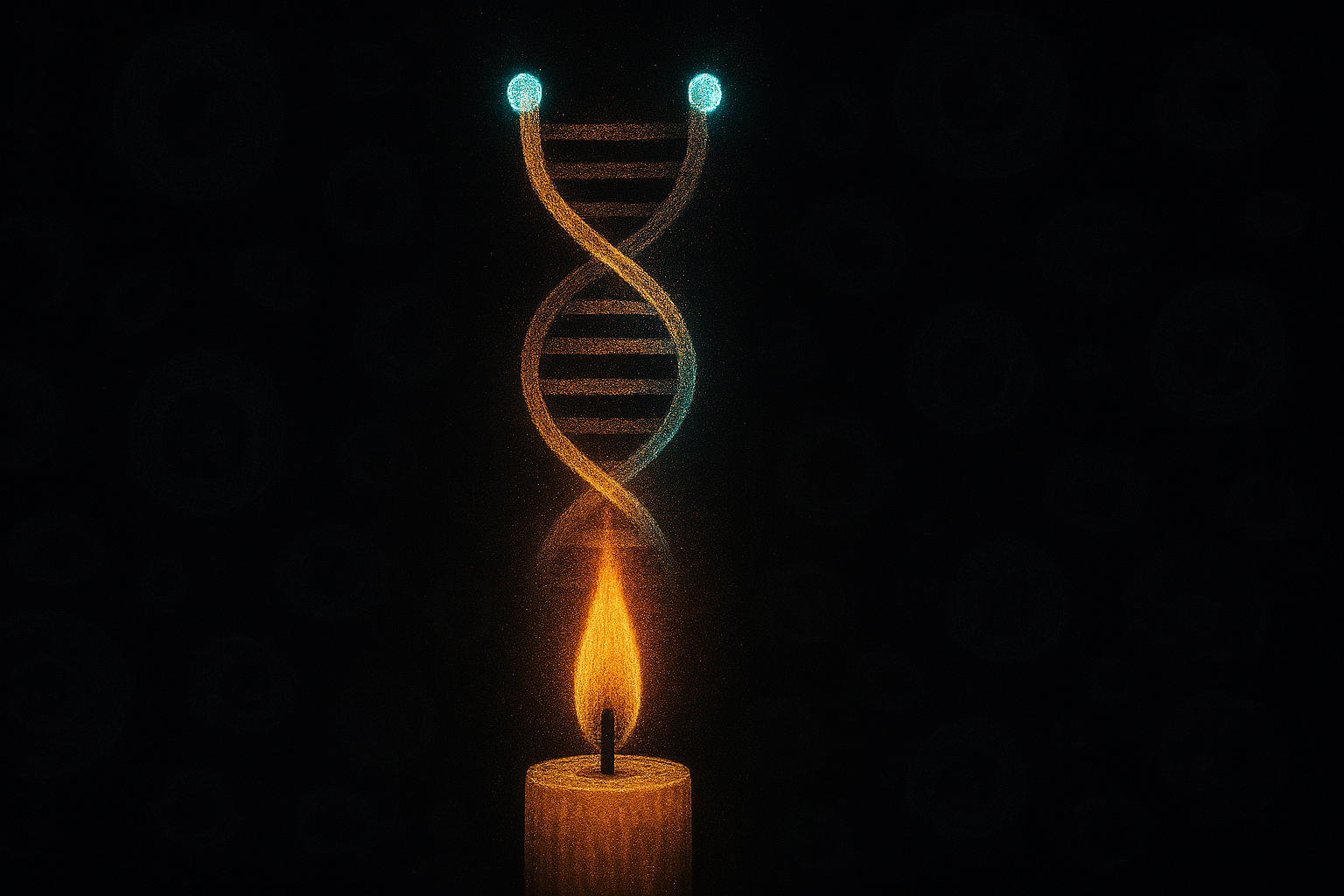Let me start this article by saying that the secret to longevity could be understood through something as simple as a candle! Just as a candle’s flame flickers while consuming the wax below, there’s a biological “candle” burning within every cell of your body—your telomeres. Like that candle, the longer your telomeres, the longer your biological lifespan. And crucially, the slower they burn, the longer you live.
Please don’t assume that this just a poetic metaphor. It’s a verified fact and is grounded in decades of scientific research that has revolutionized our understanding of aging. The 2009 Nobel Prize in Medicine was awarded to three scientists who unlocked the mystery of telomeres, revealing how these cellular timekeepers might hold the key to understanding why some people live to 100 while others succumb to age-related diseases decades earlier (Blackburn, Greider, & Szostak, 2009).
Table of Contents
The Architecture of Immortality: Understanding Telomere Biology
To appreciate how telomeres function like biological candles, we must first understand their structure and purpose. At the end of each of your 23 pairs of chromosomes sit protective caps called telomeres—repetitive DNA sequences that serve as a buffer zone, much like the plastic tips on shoelaces that prevent fraying (Shay & Wright, 2019).
These telomeres consist of thousands of repeats of a simple six-letter DNA sequence: TTAGGG. Think of them as the safety margins on a cliff—they protect the essential genetic information in your chromosomes from degradation during cell division. Every time a cell divides, these telomeres shorten slightly, losing approximately 50-100 base pairs (Sanders & Newman, 2013). This progressive shortening acts as a molecular countdown timer, determining how many times a cell can divide before reaching what scientists call the Hayflick limit—the point at which cellular senescence begins. In short, the cell will start dying once the candle of telemere burns up to certain length.
When telomeres become critically short, cells enter a state of senescence. These cells now essentially start retiring from active duty. Problem is- these senescent cells don’t die immediately; instead, they linger for some time. And while they are there, they function inefficiently leading to generation of inflammation that contribute to tissue deterioration and age-related diseases. The chemicals generated by their interactions are toxic. These harmful chemicals- known as senescence-associated secretory phenotype (SASP)– create a cascade of inflammation throughout the body (Rodier & Campisi, 2011; Coppé, Desprez, Krtolica, & Campisi, 2010).
The enzyme telomerase acts as the cellular fountain of youth, capable of adding new telomere sequences and theoretically allowing cells to divide indefinitely. However, in most human cells, telomerase activity is either very low or absent entirely, which explains why we age while simpler organisms with high telomerase activity can achieve biological immortality (Kim et al., 1994).
The Inflammatory Fire: How Modern Life Accelerates Telomere Shortening
Here’s where our candle metaphor becomes particularly illuminating. Just as heat can make a candle burn faster, certain factors can accelerate telomere shortening—and inflammation is the primary culprit.
Every breath you take, every meal you consume, every thought you think, and every step you walk generates energy through cellular metabolism. This process inevitably produces reactive oxygen species (ROS) and other inflammatory molecules as byproducts—they all lead to increase in biological heat that we call as inflammation (von Zglinicki, 2002; Wang et al., 2018). When these inflammatory molecules accumulate faster than your body can neutralize them, they create something called as oxidative stress, which directly attacks telomere DNA. In short, the heat of inflammation burns telomeres faster.
Technically, the reason why telomeres are particularly vulnerable to oxidative damage is because they’re rich in guanine bases, which are easily oxidized (Oikawa & Kawanishi, 1999). Studies have consistently shown that chronic inflammation and oxidative stress significantly accelerate telomere shortening (Jurk et al., 2014; Houben, Moonen, van Schooten, & Hageman, 2008; Serra et al., 2003). This creates a vicious cycle: shorter telomeres lead to more senescent cells, which produce more inflammatory molecules, which further accelerate telomere shortening.
Remember- Inflammation is biological heat. More the heat, faster will the candle burn.
Inflammation is the key driver of aging. It causes candles of telomeres to melt faster. More the inflammation, faster will the telomeres burn out.
Recent research has revealed that this relationship extends far beyond simple cellular aging. Cardiovascular disease, metabolic syndrome, type 2 diabetes, and even neurodegenerative diseases are all associated with both chronic inflammation and accelerated telomere shortening (Haycock et al., 2014; Sampson, Winterbone, Hughes, et al., 2006; D’Mello, Ross, Briel, et al., 2015; Epel et al., 2010). A comprehensive meta-analysis involving over 743,000 individuals confirmed that telomere length serves as a reliable biomarker of biological age, independent of chronological age (Ye et al., 2023).
The modern environment has created what evolutionary biologists call an “evolutionary mismatch”—our ancient biology struggling to adapt to pace at which new changes are being unleashed for survival (Roy, 2023; Gluckman & Hanson, 2016).
Natural evolution is the fundamental process through which living organisms adapt over time to their environment and resources. Driven by natural selection, it favors individuals best suited to survive and reproduce. Humans are the product of millions of years of this gradual change, resulting in a remarkable brain capable of complex thought, innovation, and social cooperation.
However, biological evolution is extremely slow- it takes thousands of years to just make a minor adaptation to environmental changes. If these changes in the environment are too fast, natural adaptation cannot cope up. For much of human history, environmental changes were gradual enough for evolution to keep up, but today’s rapid and dramatic changes create a “mismatch” between our genes and modern environment, leading to biological stress. This biological stress manifests as chronic inflammation.
One example I can give is diet. Human digestive systems evolved to process specific regional foods. Bengalis evolved to digest fish and rice in Bengal. Punjabis evolved to digest wheat. Globalization has expanded our diets to include foods far from ancestral norms. I am a Bengali by ancestry. My body’s biology is an outcome thousands and thousands of years of evolutionary training to convert fish and rice into energy. It was never shaped to digest wheat on a long term basis. But today I can eat hamburgers for my breakfast, parathas for lunch and pizzas for dinner. This food habit is in direct conflict to my biological set-up. There is no way that my biology can ever adapt to these dietary shocks so rapidly. Such mismatch leads to inflammation triggering diseases like diabetes, hypertension, obesity, heart disease, cancer etc.

Similar mismatch exists in terms of the lifestyles we leads today. Our ancestors generally lived in sync with natural cycles of day and night, seasons, and physical activity. They would wake up with sun and sleep when it’s dark. Modern artificial environments disrupt circadian rhythms with extended light exposure, irregular sleep, and sedentary habits, contributing to chronic health issues.
Humans are best adapted to the environments where their ancestors lived. Historically, people couldn’t travel thousands of miles to relocate, so their bodies evolved to thrive in specific climates. For example, an Eskimo’s biology is adapted to extreme cold, while an African’s is suited for extreme heat. Today, we can fly across the world in hours and settle in places with climates that don’t match what our bodies were built for. When people move to a vastly different environment, they often face health challenges. Shift an African to a cold country. Or shift an Eskimo to hot country. Both will soon develop like diseases of chronic inflammation like diabetes, hypertension, heart disease, cancer etc.
I have written a detailed article on this. Please click HERE to read.
The Rate of Living: Why Slower May Be Longer
The wisdom embedded in the candle metaphor extends to an observation that has intrigued scientists for decades: across the animal kingdom, there’s an inverse relationship between metabolic rate and lifespan. Smaller animals with faster metabolic rates tend to live shorter lives, while larger animals with slower metabolic rates often enjoy extended lifespans. This principle, known as the “rate of living theory,” suggests that organisms have a finite amount of metabolic energy, and those that “burn” it more slowly live longer (Pearl, 1928; Speakman, 2005).
In humans, this translates to a fascinating paradox: the less you do, the longer you may live—but only to a point. Studies of Blue Zones, regions where people routinely live past 100, reveal populations that embody this principle naturally. Okinawan centenarians, Sardinian shepherds, and Costa Rican farmers share several characteristics: moderate physical activity (not intense exercise), plant-based diets, strong social connections, and lifestyles that minimize chronic stress (Buettner, 2012; Willcox, Willcox, Todoriki, et al., 2007).
Consider the traditional Okinawan philosophy of “Hara Hachi Bu”—eating until only 80% full. This practice naturally reduces metabolic load and has been linked to extended lifespans. Research on caloric restriction has consistently shown that reducing calorie intake by 20-30% (while maintaining nutritional adequacy) can extend lifespan in numerous species and is associated with longer telomeres in humans (Fontana, Partridge, & Longo, 2010; McCay, Crowell, & Maynard, 1935;).
The mechanism appears to work through multiple pathways. Reduced caloric intake decreases the production of inflammatory molecules, lowers oxidative stress, and enhances cellular repair mechanisms. It also activates protective pathways like autophagy—the cellular “housekeeping” process that removes damaged proteins and organelles (Mizushima & Komatsu, 2011; Levine & Kroemer, 2008).
I have written a detailed article on this. Please click HERE to read.
The Sage’s Secret: Meditation and the Cellular Fountain of Youth
Perhaps nowhere is the candle metaphor more perfectly illustrated than in the relationship between meditation and telomere length. Ancient sages and contemplatives, who dedicated their lives to practices that slow mental activity and reduce stress, often lived remarkably long lives. Modern science is now revealing the biological mechanisms behind this longevity.
A groundbreaking study found that long-term meditation practitioners showed a remarkable phenomenon: age showed no association with telomere length in meditators, while the typical age-related telomere shortening was clearly evident in control groups (Schutte & Malouff, 2014; Lavretsky et al., 2013). Even more striking, meditation was associated with specific epigenetic changes at telomere-regulating genes, suggesting that contemplative practices can literally rewrite the cellular aging program (Jacobs et al., 2011).
Multiple studies have demonstrated that meditation practices can increase telomerase activity—the enzyme responsible for protecting telomeres (Conklin et al., 2019).
The research suggests that the less you think, the more you live—not because thinking itself is harmful, but because chronic mental hyperactivity, worry, and rumination create sustained stress responses that accelerate cellular aging (Wolkowitz et al., 2011; Ornish et al., 2008).

The concept of “slowing down” sounds counter-intuitive especially in today’s age where everyone is motivated to spend hours in gyms and physical activities in an attempt to remain healthy and live long. But- fact is- relationship between exercise and health is a double-edged sword. While physical activity is crucial for well-being, its benefits depend on the type, intensity, and duration. More is not always better; the impact of exercise follows an inverted U-shaped curve. At moderate levels, exercise improves cardiovascular health, builds muscle, and reduces disease risk. However, pushing too hard leads to diminishing returns and even harm. Excessive exercise causes inflammation. If you exceed what your body can tolerate everyday, it will lead to chronic inflammation.
The goal of any exercise should be to to challenge the body enough for positive adaptation without causing chronic stress. Go slow. Slowly increase your body’s resilience so that it can exercise more without generating inflammation. The best guide for a healthy routine is the body itself. Listen to your body—it’s the best doctor.
I have written a detailed article on this. Please click HERE to read.
Therapeutic Interventions: Slowing the Burn
Understanding telomere biology has opened new avenues for therapeutic intervention. Several approaches show promise for slowing telomere shortening or even extending telomere length:
Compounds like TA-65 can increase telomerase activity in human cells. Clinical trials show modest improvements in telomere length and immune function, though long-term safety data remains limited (Harley et al., 2011). Several medications commonly used for other conditions show telomere-protective effects. Metformin, a diabetes medication, appears to slow telomere shortening (Kulkarni et al., 2020). Similar benefit has been seen with statins– medicines that help reduce cholesterol (Spyridopoulos et al., 2004).
I personally believe that any medicine that reduces inflammation would eventually activate telomerase and help reduce the rate at which telomeres shorten.
Given the fact that we cannot really avoid the rampant inflammation due toe effects of globalization (that we discussed earlier), it’s my firm belief that everyone should start taking 75 mg Aspirin and 500 mg Metformin once daily after the age of 40 years (unless contraindicated), alongside resorting to deep meditation, good sleep and Pranayama and Patanjali Yoga.
Needless to say, please DO NOT follow any of my advice on medicines without consulting your physician.
Why Some Candles Burn Longer without effort?
Studying individuals who live past 100 reveals fascinating insights into exceptional telomere maintenance. Centenarians don’t simply have longer starting telomeres; they show slower rates of telomere shortening throughout their lives (Sebastiani & Perls, 2012; Terry et al., 2008). Genetic studies reveal that centenarians often carry protective variants in genes related to telomere maintenance, DNA repair, and stress response.
Centenarian offspring studies also provide particularly valuable insights. Children of centenarians also show longer telomeres, enhanced stress resistance, and improved metabolic profiles compared to age-matched controls, even when controlling for lifestyle factors (Sebastiani & Perls, 2012; Terry et al., 2008).
This simply means that some people are just born lucky! They simply have the right genes.
However, one must also remember that genetics accounts for only about 25% of longevity variation—lifestyle factors are far more influential (Sebastiani & Perls, 2012).
Conclusion: The Wisdom of the Candle
The candle metaphor for telomeres offers profound insights into the nature of aging and longevity. Like a candle, our biological lifespan is determined both by the initial length of our telomeres and the rate at which they shorten throughout life. The factors that lead to chronic inflammation act to intensify this flame that melts telomeres. Anything that can reduce chronic inflammation will slow telomere shortening—meditation, moderate exercise, limited food intake, mental peace, good sleep, following natural circadian rhythm (like sleeping early at night and waking up early in the morning) etc.
Ancient wisdom aligns with modern scientific understanding of telomere maintenance. The advice to “think less, move gently, eat moderately, and love deeply” isn’t just philosophy; it’s a prescription for cellular longevity.
The candle of life may inevitably burn down, but we now have the knowledge to ensure it burns as slowly and brightly as possible.





